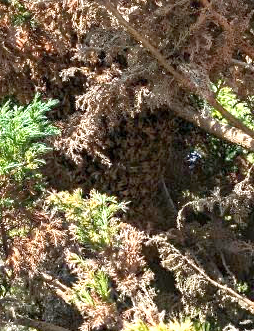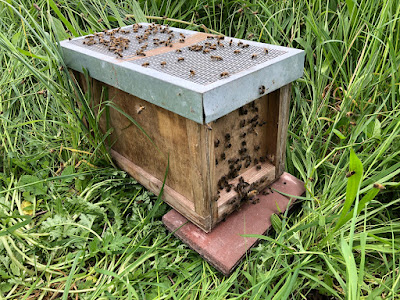Well, it has been quite a season, and I have been entirely neglectful in providing any updates since the start of this year. So, here's a catch-up on everything so far. It has very much been a tale of two cities (hives), as we shall see...
Hive Number 1
Sadly, queen Nettie and her colony didn't make it through the winter. I'm not sure why, but when I finally got to open the hives at the end of April (after the long, cold spring weather) the bees were all dead. So the first job of the year was to take off the supers (there was usable honey in the frames) clean out the dead bees, and burn the brood frames.
However, it wasn't all bad news. Queen Eunice had made it through the winter, and her colony was in great shape. In fact, the hive was really very full of bees, and I was a little nervous that they might use the fact that they were a strong, healthy colony to make a swarm. As it happens, the need to head off that possibility actually created an opportunity to re-stock hive #1. Therefore, in May I did a split, moving Eunice and half her bees and brood into the now vacant hive #1. Ever since then, hive #1 has been a model of good behaviour under Eunice's leadership - no attempts to make queen cells or swarm, very well behaved, and busy. Over the course of the year they have filled two supers with honey, and started to draw comb in a third. Currently, they are in good shape going into winter, and the only things left for me to do are remove the queen excluder and add the mouse guards. It has been a nice, easy season of beekeeping - and not even any stings.
However, things have been rather different, in what I shall now refer to as...
The Ballad of Hive Number 2
So, we start in mid-May with the aforementioned split. This left a fairly strong colony with plenty of bees and four frames of brood, as well as a frame with some honey and six new frames ready to draw comb. But no queen. Long-standing readers may remember that if a colony suddenly loses its queen (e.g. she dies - or in this case because I've moved her to another hive) then the workers will spot this pretty quickly. They'll then make several queen cells (usually at least half a dozen, but it can be more). And indeed, the good workers of hive #2 did just that. i spent the next couple of weeks removing surplus queen cells, until there was just one nice long one hanging down from the bottom of one of the frames.
At this point, everything was going to plan. The queen hatched out, and mated, and started laying eggs. And the bees were making plenty of comb for the new queen to lay in - as you can see here:
By the end of June, everything seemed to be on-track, and I was just about to pick a name for the new queen.
Then the bees killed her.
I don't really know why worker bees kill their queen. There are various theories that it happens if she is damaged or deformed, or she is not laying properly, or that the workers somehow 'just know' that she's a wrong 'un. I really don't know what their reason was, but whatever it was - they killed her. At which point, the cycle of creating queen cells started again, I spent another fortnight thinning out queen cells again, and then the new queen hatched and mated (again).
By this point, it was the end of July and the hive had a laying queen, so I assumed the shenanigans were over. It was past the end of swarm season, so there was no real danger that the bees would make any new queen cells. I figured everything was pretty stable, and that I could leave them to just get on with things without any further intervention from me. So in August, I went on holiday with my sister, and left the hives to their own devices.
By the time I checked hive #2 again, at the end of August, I was surprised to find that there was evidence of around 5 queen cells, all of which had hatched, and which the bees had started dismantling, This could mean only one thing.
While I was away, the bees killed their queen. Again.
I mentioned earlier that when bees make queen cells, I start removing them until there is only one left. There is a simple reason for this - bee colonies have evolved to only have one queen at any one time. If there is more than one queen cell, then that means more than one queen, and that's a problem. The bees basically have two ways of resolving this. If two queen cells hatch around the same time, and it is before the summer solstice, the first queen out will swarm with half the bees. But if it's after the solstice, none of the queens leave the hive. Instead, they fight - to the death - until there is only one left.
From the evidence of the 5 half-dismantled queen cells, I was able to roughly reconstruct events. The queen had been killed shortly after I'd last seen her at the end of July. The workers had then made 5 queen cells, and these queens all emerged in the middle of August while I was on holiday. Then, they'd basically had a 5-way deathmatch, leaving only one last queen standing.
I did see the queen during the same inspection when I saw the remains of the queen cells. She was a small wee thing, and didn't look at all like the hard-as-nails killer that took down her rivals to claim the hive. Don't judge a book by its cover, I suppose. Nor a queen by her abdomen.
Anyway - I didn't see any eggs at the end of August, so the queen must have still been doing her mating flights. When I checked yesterday, there was no brood, and it was very difficult to tell if there were any eggs in the hive. I got the magnifier app out on my phone, and had a really good look, and the best I can say at the moment is I think there is around an 80% chance that what I was looking at yesterday was eggs. I will know for sure when I check again next week.
So, that's things up-to-date as they stand at the moment. If you're wondering about honey, there is a bit of an update on that, which I'll cover in the next update.
















